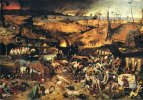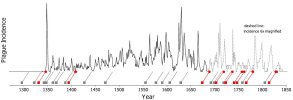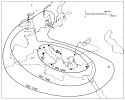You are using an out of date browser. It may not display this or other websites correctly.
You should upgrade or use an alternative browser.
You should upgrade or use an alternative browser.
Mass Extinctions, Evolutionary Leaps, and the Virus-Information Connection
- Thread starter Pierre
- Start date
Chapter 18: The Black Death
Fatality and duration
Like the Plague of Justinian, the Bleak Death lasted several centuries from its first recorded apparition in 1347 until 1850[1] and it, likewise, exhibits numerous outbreaks – evaluated officially[2] to 16[3] in total:
© Schmid BV et al.
Plague incidences in Europe, 1347-1850. Graph produced on the basis of data from Biraben[4]
Plague incidences in Europe, 1347-1850. Graph produced on the basis of data from Biraben[4]
The Black Death was the most deadly pandemics in recorded history, it is said to have killed possibly two thirds of the entire population of Europe, not to mention hundreds of millions all over the planet. According to various estimates, the first outbreak alone that lasted from 1347 to 1353 caused between 75 and 200 million deaths.[5]
Recent research into European death tolls also suggest a figure of about 50%[6] of the total European population dying during a four-year period, though the figure fluctuated from place to place. In Mediterranean Europe and Italy, the South of France and Spain, it was probably closer to 70% to 75%[7] of the total population.
Pathogenic agent
There is compelling evidence that the Black Death was not an outbreak of bubonic plague, whose pathogenic agent is Yersinia pestis, a bacterium. This case is synthesized by historian Samuel K. Cohn[8] who discovered several irreconcilable inconsistencies in the Bubonic plague hypothesis:
- Very different transmission speeds: the Black Death spread 385 km in 91 days, compared to 12-15 km a year for the modern Bubonic Plague, which has the assistance of trains and cars
- Difficulties with the attempt to explain the rapid spread of the Black Death by arguing that it was spread by the rare pneumonic form of the disease - in fact this form killed less than 0.3% of the infected population in its worst outbreak in Manchuria in 1911
- Different seasonality: the modern plague can only be sustained at temperatures between 50 and 78 °F (10 and 26 °C) and requires high humidity, while the Black Death occurred even in Norway in the middle of the winter and in the Mediterranean in the middle of hot dry summers
- Very different death rates: in several places over 75% of the population appears to have died; in contrast the highest mortality for the modern Bubonic Plague was 3% in Mumbai in 1903
The last nail in the coffin of the bubonic plague theory came from Gunnar Karlsson[9] who, in 2000, pointed out that the Black Death killed between half and two-thirds of the population of Iceland, although there were no rats in Iceland at this time.
Researchers Duncan and Scott[10] carefully put all the available clues together, tracking the plague from its first appearance out of nowhere and chronicling its unprecedented catastrophic effects on European civilization - death on a scale that is unimaginable, but could very well happen again, at any time.
They were able to not only surmise the amount of time from the appearance of symptoms to death, but also to establish the incubation period, latent period, period between symptoms and death, infectious period before the first symptoms.
The two authors were astonished when they were able to work out the duration of these statistics in more than 50 different plague outbreaks in England and to verify the length of the latent and infectious periods many times. The correspondence with the universal 40-day ‘quarantine’ period established as successful prophylaxis during the time of the plague supported their conclusions. From the data available in other countries, they argue convincingly that these statistics applied to the Black Death in all of Europe.
Duncan and Scott also analyzed and compiled the accounts relative to the plague symptoms:
- A victim usually displayed the symptoms for about five days before dying. But according to contemporary accounts, this period could have been between two to twelve days.
- The main diagnostic feature was the appearance of hemorrhagic spots, often red, but ranging in color from blue to purple and from orange to black. They often appeared on the chest, but were also seen on the throat, arms and legs and were caused by bleeding under the skin from damaged capillaries.
- Various swellings were also characteristic of the disease: carbuncles, blains (burning ulcers) and the buboes, which were swollen lymph glands in the neck, armpits and groin. If the buboes failed to rise and burst, there was little chance of survival, but if they broke the fever apparently declined.
- Fever, continual vomiting, diarrhea, and prolonged bleeding from the nose were additional characteristics. Also, blood-tinged urine, a burning thirst, and in some, madness and delirium.
- Autopsies revealed generalized necrosis of the internal organs. It was surely a gruesome way to die. The victim was killed by the literal death and liquefaction of the organs.
No known virus existing today is responsible for the Black Death, although the symptoms resemble those of Ebola, Marburg and other viral hemorrhagic fevers - diseases caused by filoviruses. They have a high mortality rate and tend to occur in explosive epidemics driven by person-to-person transmission. Outbreaks occur unpredictably and, as of yet, no animal reservoir is known.
And after centuries of periodic activity, the Black Death suddenly vanished. Where did the disease go? Did the virus mutate, causing other fearsome diseases?
What we do know is that a more virulent form[11] of smallpox came to the fore in the 1630s and, just as the Black Death started disappearing from the stage of history, smallpox took its place as the most feared of human diseases, during the 20th century only, smallpox is estimated to have killed 500 million people[12]:
Notice in the graph above, the dashed line represents the plague incidence over the years 1680-1830, but this incidence is magnified six times. It’s as if we have one graph for two different diseases: the Black Death from 1348 and 1680 (high incidence) which would have lasted about two centuries like the plague of Justinian and another disease, smallpox or bubonic plaque from 1680 to 1830.
There is one difference between the two viruses, unlike the Black Death virus, the smallpox virus is very resistant to cold temperatures, making it a more viable virus. Apart from temperature resistance hemorrhagic smallpox is virtually identical to the Black Death:[13]
Nevertheless, by using a population genetic framework that takes into account the temporal pattern & age-dependent nature of specific diseases, biochemists find that smallpox (Variola major virus) is more consistent with this historical role. And we should point out that the cumulative number of deaths during the last 700 years from smallpox was greater than that from plague [14]
Notice that the main stream theory about the origins of the Black Death and of the Justinian plague, is a bubonic plague caused by bacterial infection: Yersinia Pestis. This is based on not much evidence. A circumstantial one is the finding of Yersinia Pestis’ DNA on archeological remains.
Indeed, teeth pulp extracted from the corpses dating from the plague of Justinian reveal DNA sequence of bubonic plague but it doesn't that the victims died of bubonic plague[15], just that were carriers. In the same today, dead with the SARS-CoV-19 doesn't necessarily mean dead from SARS-CoV-19[16], far from it!
Also, as we previously said, Bubonic plague doesn't fit at all with the mortality, the geographic scope, the diffusion speed exhibited by the Black Death of the plague of Justinian, hemorrhagic viruses do.
Origin
Now, let’s focus our attention on the origin of the Black Death. As we shall soon discover[17], viruses can be carried on by comets and this factor can come into play even without impact scenarios being involved. Coincidentally, Comet Negra was observed in 1347, around the time when the epidemics started. Several chroniclers reported this event:
In France … was seen the terrible Comet called Negra.[18]
Leading dendrochronologist Mike Baillie presents a substantial body of evidence[19] showing that cometary events were the initiators of the Black Death as well as many other cataclysms. Thus the high mortality rates mentioned were not solely due to the Black Death pandemic. This period of history was marked by various interrelated catastrophes.
Philip Ziegler collected many of these disasters from medieval chronicles:
Droughts, floods, earthquakes, locusts, subterranean thunder, unheard of tempests, lightning, sheets of fire, hail stones of marvelous size, fire from heaven, stinking smoke, corrupted atmosphere, a vast rain of fire, masses of smoke. [20]
Amongst all those catastrophes, earthquakes were particularly prominent. In the 1340s there was a veritable rash of earthquakes, the most prominent the great earthquake on 25 January 1348:
In the thirty-first year of Emperor Lewis, around the feast of the Conversion of St. Paul there was an earthquake throughout Carinthia and Carniola which was so severe that everyone feared for their lives. There were repeated shocks, and on one night the earth shook 20 times. Sixteen cities were destroyed and their inhabitants killed.... Thirty-six mountain fortresses and their in habitants were destroyed and it was calculated that more than 40,000 men were swallowed up or overwhelmed[21].
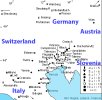
© Ambraseys – adaptation Sott.net
Effect distribution of the 1348 earthquake. The quake was felt in most of the European countries
Insofar as the mortality arose from natural causes its immediate cause was a corrupt and poisonous earthy exhalation, which infected the air in various parts of the world... I say it was the vapour and corrupted air which has been vented - or so to speak purged - in the earthquake that occurred on St. Paul's day [1348], along with the corrupted air vented in other earthquakes and eruptions, which has infected the air above the earth and killed people in various parts of the world.[22]
But notice that according to Hecker’s account the pestiferous, deadly wind did not follow but precede the great earthquake:
On the island of Cyprus, the plague from the East had already broken out; when an earthquake shook the foundations of the island, and was accompanied by so frightful a hurricane, that the inhabitants who had slain their Mahometan slaves, in order that they might not themselves be subjugated by them, fled in dismay, in all directions. The sea overflowed--the ships were dashed to pieces on the rocks, and few outlived the terrific event, whereby this fertile and blooming island was converted into a desert. Before the earthquake, a pestiferous wind spread so poisonous an odour, that many, being overpowered by it, fell down suddenly and expired in dreadful agonies.[23]
So what caused the “pestiferous wind” that preceded the great earthquakes, and possibly the earthquake itself? Earthquakes and cometary events can be closely related as Baillie points out:
earthquakes could be caused by cometary explosions in the atmosphere or even impacts on the surface of the earth[24]
This link is confirmed by own research[25]: cometary events can be the cause of earthquakes.
Then, Baillie shows that the exact same signature is present at the time of the Black Death in both the tree rings and in the ice cores, and at other times[26] of so-called ‘plague and pandemic’. In particular, tree rings and ice-core revealed a spike in ammonium ca. 1347 AD.
There are only four occasions in the last 1500 years: 539, 626, 1014, and 1908 which display a prominent ammonium spikes. Coincidently or not, each of these four dates is clearly associated with a cometary event:
539 AD: as detailed in the previous chapter[27].
626 AD: ammonium spike concomitant with meteor swarm observations:
Michael Purser ,after a lecture in Dublin noticed that ” in frescoes relating to the Siege of Constantinople in 626 […] there were ‘stars falling from the sky ‘ associated with a turbulent sea. Corroborating this fireball imagery is an entry in the West Syrian Chronicles dated to the same year: AD 626 Shooting stars to the north.”[28]
1014 AD: Baillie has suggested that 1014 may be an impact year because there was a report of a close comet, as well as a sea flood, and the ammonium signal[29]. Abbott[30] confirmed Baillie’s analysis citing evidence of an impact coinciding with evidence for an Atlantic tsunami.
The close passing 1014 comet identified by the retro-calculations of Sekanina and Yeomans[31] may not be coincidental. In addition there is interesting entry in the Annales Magdaburgenses for the year 1014:
Stella apparuit [a star appeared][32]
1908 AD: the exact year of the Tunguska event overhead cometary explosion that flattened 1200 km2 of forest[33].
Tunguska is particularly interesting because it had very particular signature: the above mentioned ammonium spike in conjunction with a cobalt/REE[34] spikes:
Of interest too is an analysis of the element composition in one northern peat bog column from the 1908 Tunguska explosion epicenter published by Xie et al that showed concentrations of Pd , Ni , Co ,Ti , Y and REE in the event and lower layers are higher than the background values for the upper layers […] eight times for Ni , ten times for Co […] and fifteen times for REE respectively ” […] The Cobalt and REE abundances are coeval at a depth corresponding to 1908 when a comet chunk detonated over Siberia[35]
In addition, the Tunguska bolide induced a shock wave equivalent to an earthquake measuring 5.0 on the Richter magnitude scale[36].
The beginning the Black Death exhibits all the features of the Tunguska event. Namely the above mentioned Great earthquake and ammonium spike, plus a distinct Cobalt/REE spikes:
The cobalt and rare earth element indices escalating from AD 1300 – 1350 visible in the REE -index and Cobalt[…]that points to another cometary debris bombardment episode in the 14th century. The REE /cobalt index looks fairly robust over the last 2 – 3 millennia at least[37]
And, of course, we have numerous corroborating observations of cometary events reported by reliable eyewitness in France, in Germany and in the Arabic World:
Read the eyewitness reports of the Paris Medical Faculty and Hecker’s description […] before the Cyprus earthquake …An Arabic source even links the plague to a “high explosion”[38]
Here is the report written Justus Hecker[39]:
[…] a fiery meteor, which descended on the earth far in the East, [and] destroyed everything within a circumference of more than a hundred leagues, infecting the air far and wide.[40]
All the markers at the beginning the Black Death are also present during the Tunguska event, albeit on a larger scale:
The cobalt and REE series[…].Both series show an uptick around 1300 – 1350 with the REE spike [or interpretive ‘artifact ‘] dominating the REE multi centennial LIA sequence at a time of comet sightings fireballs, “quakes ” floods, global tree ring growth downturns famine and mass deaths.[41]
In short, there seems to be a connection between of (overhead) cometary bombardments, earthquakes, ammonium and Cobalt/REE spikes, as clearly shown for example during the Tunguska event.
Worth of notice and strengthening the comet hypothesis further is Jon Arrizabalaga[42] analysis of the meaning of “Black Death”. For this purpose, he compiled a selection of writings in an attempt to understand what educated people were saying about the Black Death while it was happening. Regarding the terms used by doctors and other medical people in 1348 to describe the plague, he writes:
Jaume d'Agramunt[43], discussed it in terms of an "epidemic or pestilence and mortalities of people" which threatened Lerida from "some parts and regions neighbouring to us" ... Agramont said nothing concerning the term epidemia, but he extensively developed what he meant by pestilencia. He gave this latter term a very peculiar etymology [...], which came to be widely accepted throughout Europe during the Middle Ages. He split the term pestilencia up into three syllables, each having a particular meaning: pes = tempesta: 'storm, tempest'; te = 'temps, time', lencia = clardat: 'brightness, light'; hence, he concluded, the pestilencia was 'the time of tempest caused by light from the stars.' [44]
In the end It’s not clear whether the Black Death Virus was carried by comet Negra and/or by the comet that caused the great earthquake and/or by the numerous meteoric that fell upon the Earth between these two events.
Another data suggesting that the Black Death was an airborne pathogen is the geographic spread pattern, where the epidemics doesn’t flow usual humans and/or rats pathways but dominant winds:
The Black Death […] has all the hallmarks of a space incident component or trigger. […] the progression of the disease did not follow contours associated with travel routes, displaying a patchiness of incidence including zones of total avoidance.[45]
The map above shows that cities like Milan, Bruges or Warsaw were virtually untouched by the Black Death. How could these very busy cities escape the pandemics if the contagion vectors were rats? But if the Black Death was a space borne virus a certain drop down patchiness should be expected, as well as a geographic diffusion pattern following dominant winds:
Moreover, the pattern of infection appears to travel the course of prevailing winds […] This does not accord with straightforward infection via a rodent/flea carrier as is conventional to assume.[46]
Indeed, the yearly spread map of the Black Death reveals concentric circle centered on the Mediterranean Sea and spreading evenly in all direction. It suggests that the pathogen initially descended from the atmosphere somewhere in the Mediterranean Sea and was subsequently spread by the winds:
Notice Italy might even have been the first country affected in the world since the alleged migration from Crimea to Italy doesn’t stand factual scrutiny[47]. If Crimea was not the source of the epidemics that contaminated Sicily and then Europe, the already sketchy official chronology becomes impossible:
In conclusion, the epidemics that ravaged Europe were not bubonic plague but very probably a hemorrhagic virus, related to smallpox. The pathogen was not carried by rats but airborne disseminated from high atmosphere after a cometary explosion. The Black Death pandemic was one aspect of a series of cometary-induced cataclysms, including earthquakes that brought its knees the medieval European civilization.
[1] Byrne, Joseph Patrick (2008) “Encyclopedia of Pestilence, Pandemics, and Plagues: A–M” ABC-CLIO. p. 519
[2] We will go back to this point in the next subchapter: “Pathogenic agent”
[3] Boris V. Schmid et al. (2015) “Climate-driven introductions of plague into Europe” PNAS 112 (10) 3020-3025
[4] Biraben JJN (1976) ‘’Les hommes et la peste en France et dans les pays européens et méditerranéens’’ Mouton, Paris-La Haye
[5] Edwards, K. (2012) “And America Quaked: A Chilling Series of Visions of a Future American” Wheatmark, p.100
[6] Daileader, Philip (2007) “The Late Middle Ages” The Teaching Company
[7] Daileader, op. cit.
[8] Samuel K. Cohn Jr. (2002) “The Black Death Transformed: Disease and Culture in Early Renaissance Europe” Oxford University Press
[9] Karlsson, G. (2001) “The History of Iceland” University of Minnesota
[10] Susan Scott & Christopher Duncan (2004) “Return of the Black Death” Wiley
[11] Smallpox was first identified in 10,000 BC, albeit a less virulent form. See part III, chapter “Viruses Contribute to Mass Extinctions”
[12] David A. Koplow (2003) “Smallpox—The Fight to Eradicate a Global Scourge.” University of California Press.
[13] Segura, G. (2011) “New Light on the Black Death: The Viral and Cosmic Connection” The Dot Connector Magazine, issue 13, volume 1
[14] Galvani, Alison et al. (2004) “Evaluating plague and smallpox as historical selective pressures for the CCR5-Δ32 HIV-resistance allele” PNAS 100. 15276-9
[15] Drancourt M. et al. (2004) “Genotyping, Orientalis-like Yersinia pestis, and plague pandemics” Emerg Infect Dis. 10(9):1585-92
[16] See Part VI : ‘’6th Extinction and coronavirus’’
[17] See chapter 20: “Meteorites carrying microorganisms”
[18] Short, T. (1749) “A General Chronological History of the Air, Weather, Seasons, Meteors, Etc” London
[19] Baillie M. (2006) “New Light on the Black Death: The Cosmic Connection” The History Press
[20] Ziegler, P. (2009) “The Black Death” Harper Perennial Modern Classics
[21] Horrox, R. (1994) “The Black Death” Manchester University Press
[22] Medieval German treatise quoted in Horrox R., op. cit.
[23] Justus Friedrich Karl Hecker (2019) “The Black Death” Books on Demand
[24] Baillie, M., op. cit.
[25] Lescaudron, 2021 chapter “Correlation between Cometary Activity, volcanism and earthquakes”
[26] The 539 AD signal that closely precedes the outbreak of the plague of Justinian in 541 AD
[27] See previous chapter about the plague of Justinian
[28] Deep Tusk Contributors (2022) “Fascinating exchange on the cause and timing of the 530's AD climate chaos’ Deep Tusk
[29] Baillie M. (2007) “The case for significant numbers of extraterrestrial impacts through the late Holocene” Journal Of Quaternary Science 22(2) 101–109
[30] Abbott, D. et al. (2014) “What Caused Terrestrial Dust Loading and Climate Downturns Between 533 and 540 A.D.?” Special Paper of the Geological Society of America 505. 421-427. 10.1130/2014.2505(23)
[31] Yeomans, Donald et al. (2004) “Cometary orbit determination and nongravitational forces” Comets II
[32] Annales Magdaburgenses MGH SS ,xvi 165
[33] Zurab K. Silagadze (2003) “Tunguska genetic anomaly and electrophonic meteors” Acta Phys.Polon. B 36 935
[34] Rare Earth Material
[35] Deep Tusk Contributors (2022) “Fascinating exchange on the cause and timing of the 530's AD climate chaos’ Deep Tusk
[36] Traynor, Chris (1997) "The Tunguska Event" Journal of the British Astronomical Association 107 (3)
[37] Deep Tusk Contributors, 2022
[38] Deep Tusk Contributors, 2022
[39] (1795-1850) German physician and medical writer, whose works appear in medical encyclopedias and journals of the time. He particularly studied disease in relation to human history, including plagues.
[40] World Archaeology Editors (2007) “Review: New Light on the Black Death: the cosmic connection” World Archaeology
[41] Deep Tusk Contributors, 2022
[42] Research Professor in the History of Medicine and Science, and deputy director of the IMF in the Spanish National Research Council
[43] Catalan doctor and writer, who died in Lleida, Catalonia, Spain in 1350. In the face of the incredible toll taken across Europe by the Black Plague, on April 23, 1348 he provided the Mayor of Lleida with his Directions for Protection from the Plague
[44] Amanda Laoupi (2016) “Fires from Heaven. Comets and diseases in circum-Mediterranean Disaster Myths” Centre for the Assessment of Natural Hazards & Proactive Planning – NTUA
[45] Rhawn J. et al. (2010) “Comets and Contagion: Evolution and Diseases From Space” Journal of Cosmology, Vol 7, 1750-1770
[46] Ibid
[47] Hannah Barker (2021). “Laying the Corpses to Rest: Grain, Embargoes, and Yersinia pestis in the Black Sea, 1346–48” Speculum 96
I think it's Lewis IV (German: Ludwig) 1 April 1282 – 11 October 1347, called the Bavarian. To be checked though.In the thirty-first year of Emperor Lewis,
Lewis, in French ????
Great chapter Pierre. Thank you!
In the last sentence:
In the last sentence:
-> brought to its kneesincluding earthquakes that brought its knees the medieval European civilization.
Benjamin
The Living Force
Another good chapter, Pierre!
or
...which each display a prominent ammonium spike.
also
-...spike.
also
-...shown, for example, during... (Needs commas)
also
-...where the epidemics don't follow the usual human and/or rat pathways but are instead spread by dominant winds:...
(or)
-...where the epidemics don't flow through the usual human and/or rat pathways but are instead spread by dominant winds:...
also
-...brought the medieval European civilization to its knees.
- ...pandemic...The Black Death was the most deadly pandemics in recorded history
-...death, and infectious...period between symptoms and death, infectious period before the first symptoms.
-...reveal DNA sequences of bubonic plague but it doesn't mean/seem/show/prove that the victims died of the bubonic plague...Indeed, teeth pulp extracted from the corpses dating from the plague of Justinian reveal DNA sequence of bubonic plague but it doesn't that the victims died of bubonic plague
-...the diffusion speed exhibited by the Black Death or the plague of Justinian like hemorrhagic viruses do.Also, as we previously said, Bubonic plague doesn't fit at all with the mortality, the geographic scope, the diffusion speed exhibited by the Black Death of the plague of Justinian, hemorrhagic viruses do.
-...prominent being the...In the 1340s there was a veritable rash of earthquakes, the most prominent the great earthquake on 25 January 1348:
-...by my own...This link is confirmed by own research
-...ice-cores...In particular, tree rings and ice-core revealed a spike in ammonium ca. 1347 AD.
-...which display (delete 'a') prominent ammonium spikes.There are only four occasions in the last 1500 years: 539, 626, 1014, and 1908 which display a prominent ammonium spikes.
or
...which each display a prominent ammonium spike.
-...is an interesting...In addition there is interesting entry in the Annales Magdaburgenses for the year 1014:
-...spike.Tunguska is particularly interesting because it had very particular signature: the above mentioned ammonium spike in conjunction with a cobalt/REE[34] spikes:
- In/At the beginning...The beginning the Black Death exhibits all the features of the Tunguska event. Namely the above mentioned Great earthquake and ammonium spike, plus a distinct Cobalt/REE spikes:
also
-...spike.
-...written by Justin...Here is the report written Justus Hecker
-...growth, downturns, famine... (This is a quote. Needs commas.)floods, global tree ring growth downturns famine and mass deaths.[41]
-...between the (overhead)... (or)... delete 'of'In short, there seems to be a connection between of (overhead) cometary bombardments, earthquakes, ammonium and Cobalt/REE spikes, as clearly shown for example during the Tunguska event.
also
-...shown, for example, during... (Needs commas)
-...Worthy of note, and strengthening the comet hypothesis, is Jon Arrizabalaga's analysis...Worth of notice and strengthening the comet hypothesis further is Jon Arrizabalaga[42] analysis of the meaning of “Black Death”.
- Agramunt or Agramont? (This is a quote.)Jaume d'Agramunt[43], discussed it in terms of an "epidemic or pestilence and mortalities of people" which threatened Lerida from "some parts and regions neighbouring to us" ... Agramont said nothing concerning the term epidemia
-...end, it's...In the end It’s not clear whether the Black Death Virus was carried by comet Negra and/or by the comet that caused the great earthquake and/or by the numerous meteoric that fell upon the Earth between these two events.
- Other data suggesting... (or) - Another data point suggesting...Another data suggesting that the Black Death was an airborne pathogen is the geographic spread pattern, where the epidemics doesn’t flow usual humans and/or rats pathways but dominant winds:
also
-...where the epidemics don't follow the usual human and/or rat pathways but are instead spread by dominant winds:...
(or)
-...where the epidemics don't flow through the usual human and/or rat pathways but are instead spread by dominant winds:...
-...circles... directions.Indeed, the yearly spread map of the Black Death reveals concentric circle centered on the Mediterranean Sea and spreading evenly in all direction.
- Notice that Italy... (Might not need to be added.)Notice Italy might even have been the first country affected
-...by rats but was instead airborne, disseminating from the high atmosphere... (or)... being disseminated...The pathogen was not carried by rats but airborne disseminated from high atmosphere after a cometary explosion. The Black Death pandemic was one aspect of a series of cometary-induced cataclysms, including earthquakes that brought its knees the medieval European civilization.
also
-...brought the medieval European civilization to its knees.
-...See Part III, Chapter 11,[11] Smallpox was first identified in 10,000 BC, albeit a less virulent form. See part III, chapter “Viruses Contribute to Mass Extinctions”
Corrected in the master file. Thanks!
Another good chapter, Pierre!
- ...pandemic...
-...death, and infectious...
-...reveal DNA sequences of bubonic plague but it doesn't mean/seem/show/prove that the victims died of the bubonic plague...
-...the diffusion speed exhibited by the Black Death or the plague of Justinian like hemorrhagic viruses do.
-...prominent being the...
-...by my own...
-...ice-cores...
-...which display (delete 'a') prominent ammonium spikes.
or
...which each display a prominent ammonium spike.
-...is an interesting...
-...spike.
- In/At the beginning...
also
-...spike.
-...written by Justin...
-...growth, downturns, famine... (This is a quote. Needs commas.)
-...between the (overhead)... (or)... delete 'of'
also
-...shown, for example, during... (Needs commas)
-...Worthy of note, and strengthening the comet hypothesis, is Jon Arrizabalaga's analysis...
- Agramunt or Agramont? (This is a quote.)
-...end, it's...
- Other data suggesting... (or) - Another data point suggesting...
also
-...where the epidemics don't follow the usual human and/or rat pathways but are instead spread by dominant winds:...
(or)
-...where the epidemics don't flow through the usual human and/or rat pathways but are instead spread by dominant winds:...
-...circles... directions.
- Notice that Italy... (Might not need to be added.)
-...by rats but was instead airborne, disseminating from the high atmosphere... (or)... being disseminated...
also
-...brought the medieval European civilization to its knees.
-...See Part III, Chapter 11,
Corrected in the master file. Thanks. I made many mistakes in this chapter!
Benjamin
The Living Force
Corrected in the master file. Thanks. I made many mistakes in this chapter!
 Well, I think your mind is very busy. Writing these fantastic chapters can't be easy. Keep your energy focused on this monumental task. If you make a few mistakes, the members on this forum will sniff them out!
Well, I think your mind is very busy. Writing these fantastic chapters can't be easy. Keep your energy focused on this monumental task. If you make a few mistakes, the members on this forum will sniff them out! From chapter 14:
-> Tbilisi. See wiki.
Georgi Eliava established phage therapy in Tsiblisi at the Eliava Institute in 1936,
-> Tbilisi. See wiki.
-> Actually their integration in the... or Actually integration of ERVsActually their integration of ERVs in the host’s genome provides benefits:
The above fits. He was called the Bavarian.I think it's Lewis IV (German: Ludwig) 1 April 1282 – 11 October 1347, called the Bavarian. To be checked though.
I think Louis IV would be better both in English and in French. At least one will easily find it in google search with that name, where as Lewis IV does not bring much.
In English:
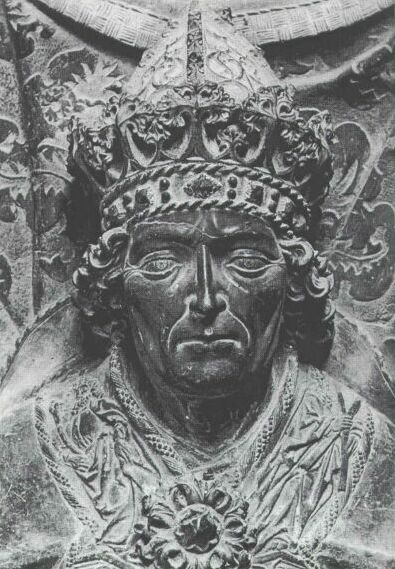
Louis IV, Holy Roman Emperor - Wikipedia
And in French:



